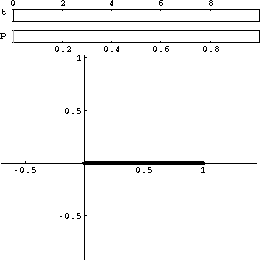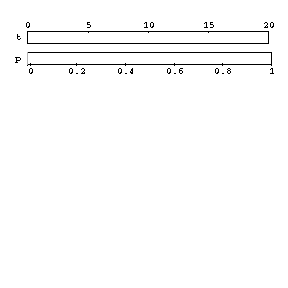tutorial at IJCAI-2001
Search Algorithms for Quantum Computers
Tad Hogg
|
Relative amplitudes for a 10 variable instance of 3-SAT with 40 clauses, using a quantum heuristic.
The amplitudes for the three solutions are in black. For the other assignments, colors indicate the number of conflicting clauses, ranging from 1 (red) to 11 (blue). All amplitudes are shown relative to the amplitude for one of the solutions.
The t bar shows the number of completed steps, alternating between phase adjustment (black) and mixing (purple).
The P bar shows the probability to obtain a solution.
|
 |
|
Relative amplitudes for a 20 variable instance of 3-SAT with 80 clauses, using a quantum heuristic.
The amplitudes for the 24 solutions are in black. For the other assignments, colors indicate the number of conflicting clauses, ranging from 1 (red) to 11 or more (blue). All amplitudes are shown relative to the amplitude for one of the solutions.
|
 |
description
Quantum computers, if they can eventually be built, will factor integers in
polynomial time, a problem thought to be intractable for conventional machines.
More directly relevant to artificial intelligence is the open question of how
rapidly they can solve NP-hard combinatorial searches. Although unlikely to
efficiently solve all NP problems, quantum computers may offer
substantial improvement for many searches that arise in practice. This
observation provides an opportunity to develop heuristic search methods for
quantum computers. Quantum algorithms, operating on the entire search space at
once, can exploit correlations among properties of search states. Furthermore,
heuristics can pose less stringent requirements on the hardware than algorithms
ignoring problem structure, thereby reducing the formidable challenge of
building these machines.
Most current work on quantum computing involves hardware, error correction
and general computational complexity results. Relatively little attention has
been paid to devising heuristics incorporating the capabilities of quantum
computers. This tutorial will help researchers familiar with the design and
analysis of search heuristics participate in creating such heuristic algorithms.
This tutorial will describe the capabilities of quantum computers relevant
for search, such as their ability to test exponentially many search states in
about the same time conventional machines test just one. Attendees will learn
how to combine these capabilities in quantum search algorithms through a variety
of examples, including random 3-SAT near a phase transition in typical search
cost. The tutorial will also cover techniques, both theoretical and empirical,
for evaluating such algorithms and a variety of open research questions that the
AI community is well-positioned to address.
The tutorial will assume some knowledge of combinatorial searches, such as
satisfiability (SAT), and heuristic methods, such as hill-climbing and GSAT.
Familiarity with quantum mechanics is not required.
For further background on the focus of this tutorial, see A Quantum Leap
for AI in IEEE Intelligent Systems, July/August 1999.
topics
- motivation
- Why the interest in quantum computing? And why for AI?
- Why develop algorithms before hardware is available?
- Why develop heuristic algorithms?
- using quantum computers
- capabilities: superposition, parallelism, interference, entanglement,
measurement
- examples of simple searches
- efficient quantum operators on exponentially many states
- techniques for algorithm design and evaluation
- using problem structure for quantum heuristics
- a case study: using state costs to solve hard random k-SAT
- additional techniques using problem structure
- open questions and research opportunities
- How can capabilities of quantum computers be best used for AI?
- What is the average performance of heuristic algorithms for hard
searches?
- Which problems have enough correlation among search state properties to
give good performance?

